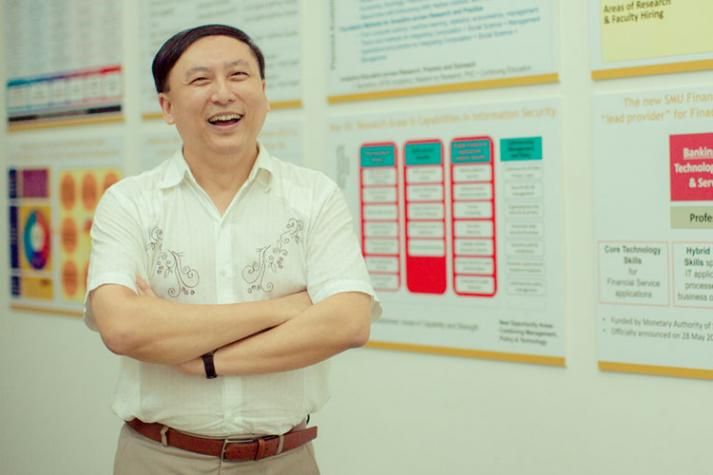
Associate Professor Lau Hoong Chuin of the SMU School of Information Systems is tackling a key challenge of urbanisation: how to manage the increasing flow of people and physical goods into cities in a sustainable manner.

Photo Credit: Darren Yau
By Lee Chan Wai
SMU Office of Research (10 Oct 2013) – The efficiency of worldwide product distribution has had such a dramatic effect on the global economy that some scholars feel it has contributed even more than the traded commodities themselves. It has even prompted one scholar to cite the invention of the shipping container latch (or twistlock) as one of the seminal inventions of the 20th century.
But that global, interconnected supply chain is starting to creak and groan under the weight of massive new trends in urbanisation.
Enter Associate Professor Lau Hoong Chuin of the Singapore Management University (SMU) School of Information Systems, who is redefining the field of urban logistics, the study of goods and services distribution within our cities.
“I am really interested in problems involving interacting flows of people and resources, with the aim of improving operational efficiency and consumer experience. I am passionate about improving our quality of life through sustainable practices that promote social and economic improvement,” says Professor Lau.
Solving the ‘last mile’ problem
In a project funded by the Agency for Science, Technology and Research (A*STAR) Collaborative Urban Logistics Programme, Professor Lau and colleagues at the SMU Urban Management & Analytics Laboratory are working closely with private companies to optimise urban freight transport and distribution systems.
The problem the researchers hope to solve is what is known as the ‘last mile’, or the transportation of urban freight from distribution centres to retailers and consumers in city centres. Goods delivery vehicles form a significant part of traffic volume in cities and the ‘last mile’ amounts to between 13 to 75 percent of the total logistics costs in Singapore.
To fully utilise the load capacity of trucks and reduce the carbon footprint, Professor Lau has developed innovative auction mechanisms that enable various stakeholders in the supply chain to collaborate. These stakeholders include logistics service providers, goods suppliers, city councils, retailers and customers. By bidding on a cloud-based e-marketplace platform, last-mile deliveries within a city can become much more synchronised, thereby improving both operational efficiency and maximising social good.
“Beyond operational optimisation, this model of the entire urban delivery chain could potentially be a policy tool,” Professor Lau explains. “It would allow us to assess government intervention and statutory requirements and their resulting effects, leading to a minimised logistics footprint that could reduce environmental impact and increase overall service level. The challenge has been to create a robust system that is scalable and applied to such a complex industry.”
Making ride-sharing schemes work
Professor Lau’s team has also found logistics solutions to a different type of cargo: people.
Funded by the Singapore-MIT Alliance for Research and Technology (SMART) Future Urban Mobility Programme, Professor Lau and his team have designed an intelligent taxi supply and passenger demand matching system to reduce single-person occupancy of commercial taxis.
Although ride-sharing schemes have been implemented before, Professor Lau is working on a more subtle problem that limits the popularity of these schemes: how does one fairly allocate the cost of travel between ride-sharers and at the same time bring additional revenue to taxi drivers? The complexity arises because the amount that passengers are willing to pay varies depending on their pick-up and drop-off location as well as personal preferences.
Here, an auction algorithm is at work again, by allowing prospective ride-sharers to specify how much they are willing to pay and matching them up dynamically. He hopes that this system will make ride-sharing a viable option in crowded megacities like Singapore, thus reducing the number of cars on the road and alleviating congestion in the city.
Serious business starts at a theme park
As Deputy Director of the SMU Live Analytics Research Centre (LARC), Professor Lau works closely with researchers from Carnegie Mellon University in the United States to solve large-scale crowd coordination problems in theme parks and other urban leisure settings.
Through their work with Resorts World Sentosa to improve the overall visitor experience, Professor Lau and colleagues know first-hand that maximising someone else’s fun can be hard work.
By tracking real-time visitor movement using GPS-enabled smartphones, the researchers can then model visitor behaviour (queuing patterns and wait times) in the park as a large-scale dynamic spatio-temporal network. To reduce bottlenecks, the information is used in a mobile app (application) that guides visitors dynamically and personally on optimised routes around the park. Theme park operators can also evaluate different crowd control mechanisms and experiment with marketing promotions to optimise visitor flow around the park.
Urbanisation has challenged academic minds for centuries - Aristotle and Plato wrote about classical Greek cities and St. Augustine studied the pressures of city life under the much larger Roman Empire. Professor Lau says it is clear that classical insights into urbanisation remain strikingly applicable to the world we live in today. Through his own work, he hopes to continue a tradition of optimising conditions for dense cities.
“With an estimate of 70 percent of the world population living in cities by 2050, particularly in Asia, how can one not be compelled to think about and make efforts to address the concerns of urban sustainability?” he says.